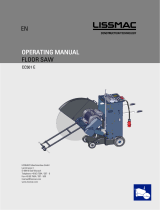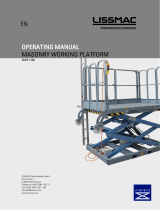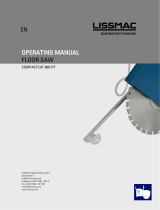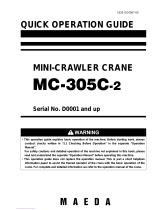Page is loading ...

1/48
OPERATING MANUAL
MINI CRANE
LMK 220
LISSMAC Maschinenbau GmbH
Lanzstrasse 4
D-88410 Bad Wurzach
Telephone +49 (0) 7564 / 307 - 0
Fax +49 (0) 7564 / 307 - 500
lissmac@lissmac.com
www.lissmac.com
EN

2/48

3/48
Imprint This operating manual is for:
LISSMAC Mini Crane
LMK 220
Headquarters:
Lissmac Maschinenbau GmbH
Lanzstraße 4
D - 88410 Bad Wurzach, Germany
Phone: +49 (0) 7564 / 307 – 0
Fax: +49 (0) 7564 / 307 – 500
lissmac@lissmac.com
www.lissmac.com
Operating Instructions
Version: 07- 2022
Keep the operating instructions for later use!
Passing on and duplication of these operating instructions in any form as well as the
use of the contents are prohibited unless permitted in writing.
Violations shall be subject to compensation. All rights reserved for
patents and registered designs or design patents.

4/48
Table of contents
1. Properties & advantages ................................................................................................. 5
1.1. Principle of intended use ................................................................................................... 9
1.2. Organizational measures ................................................................................................. 10
1.3. Selection and qualification of personnel; basic duties.................................................... 10
1.4. Safety notices regarding the operating phases............................................................... 11
1.4.1. Transport, assembly and installation ..................................................................... 11
1.4.2. Setup and commissioning ...................................................................................... 11
1.4.3. Operation................................................................................................................ 12
1.4.4. Special works within the scope of use of the machine .......................................... 12
1.5. Reference to special types of hazards ............................................................................ 13
1.5.1. Electrical energy ..................................................................................................... 13
1.6. Transportation ................................................................................................................. 13
1.7. Packing and storage ........................................................................................................ 14
1.8. Environmental protection ................................................................................................ 14
1.9. Waste disposal ............................................................................................................... 14
2. Device description ......................................................................................................... 15
2.1. Designation of the machine parts ................................................................................... 17
2.2. Technical Data ................................................................................................................ 18
2.3. Sound power level .......................................................................................................... 19
2.4. Danger area .................................................................................................................... 19
2.5. Manual control ................................................................................................................ 20
3. Transportation ................................................................................................................ 21
3.1. Transport position ........................................................................................................... 21
3.2. Transport safety .............................................................................................................. 22
4. Commissioning ............................................................................................................... 23
4.1. Substrate and environment ............................................................................................. 23
4.2. Parking brake .................................................................................................................. 23
4.3. Setup ............................................................................................................................... 24
4.4. Dismantling ..................................................................................................................... 28
4.5. Rotation lock ................................................................................................................... 30
4.6. Bolts and linchpins .......................................................................................................... 30
4.7. Disassembly into assemblies .......................................................................................... 31
5. Maintenance .................................................................................................................. 34
5.1. Maintenance ................................................................................................................... 34
5.2. Lubrication points ............................................................................................................ 35
5.3. Troubleshooting .............................................................................................................. 36
6. Regular inspection (inspection log) .............................................................................. 37
6.1. Control measurement Tilt clearance ............................................................................... 38
6.2. Maintenance schedule .................................................................................................... 39
7. Warranty ......................................................................................................................... 40
8. Hydraulic diagram .......................................................................................................... 42
9. Circuit diagram ............................................................................................................... 43

5/48
1.
PROPERTIES & ADVANTAGES
This practical LISSMAC mini crane was developed in intensive cooperation with users. Its high-quality
workmanship and easy handling of the LISSMAC mini cranes increase safety and facilitate daily work.
Base frame, tower and boom are completely hot-dip galvanized - no rust or paint damage -
durable and robust for the toughest applications
Large-dimensioned ball bearing slewing ring, smooth rotary motion
Low backlash locking of the tower
Easy assembly and disassembly with an electro-hydraulic pump - additional protection by a
safety cylinder with plug-in bolt
Transportation Possibility of relocation by forklift and crane
The chain hoist Special chain hoist protective hood against moisture
Power supply through a cable trailing device integrated in the boom
Quick disassembly of the chain hoist due to plug-in connection

6/48
BASIC SAFETY INSTRUCTIONS
Warning notices and symbols in this manual
SIGNAL WORD
Type and source of the hazard
Consequences of non-compliance
Action to avert the hazard
The signal word after the danger symbol indicates the degree of danger:
DANGER This signal word indicates an extremely dangerous situation. If the situation is not avoided, it will result in
fatal injuries. The hazard may be specified on the danger symbol.
WARNING This signal word designates a potentially dangerous situation. If the situation is not avoided, fatal or
serious injuries could result. The hazard may be specified on the danger symbol.
CAUTION This signal word designates a dangerous situation. If the situation is not avoided, medium and minor
injuries result. The hazard may be specified on the danger symbol.
NOTICE This signal word indicates a situation which may present a danger for property. If the situation is not
avoided, the consequence will be property damage. This signal word is shown without a hazard symbol.
Important information is marked with an “i”.
Request for operator action:
The specified sequence of actions facilitates orderly and safe handling of the machine.
Instructions to the operator

7/48
The following warning and safety notices are used:
Observe the operating instructions
Impact hazard in the head area
Wear safety helmet
Danger due to overturning of heavy objects
Wear safety shoes
Crush hazard
due to swiveling or unintentionally rolling
machine
Disconnect the power plug before
maintenance work
High
voltage hazard
Anchor point for crane transport
No use by unauthorized persons
Lashing point
Pick up point for the fork lift
Sound power level of the machine
Visual inspection
Danger through suspended loads
Instructions for avoiding damages
Crush hazard for hands
Spray
-on grease
Falling parts hazard
Grease gun

8/48
OPERATING MANUAL
Preface These operating instructions are intended to make it easier to get to know the machine and to use it for its
intended purpose.
The operating manual contains important information on how to operate the machine safely, properly and
economically. Observing them helps to avoid hazards, prevent repair costs and downtime, and increase the
reliability and service life of the machine.
The operating manual should be supplemented by instructions based on existing national accident
prevention and environmental protection provisions.
The operating manual must be constantly available at the place of use of the machine.
The operating manual must be read and applied by every person who is commissioned with work on the
machine e.g.:
Operation, including setup, troubleshooting in the workflow, removal of
production waste, maintenance, disposal of operating and auxiliary materials.
Maintenance (servicing, inspection, repair) and/or
Transportation
.
In addition to the operating manual and the binding accident prevention regulations applicable in the
country and location of use, the recognized professional regulations for safe and correct working practice
must also be observed.
Related documents In addition to this operating manual, further documentations from the respective manufacturer of individual
components of the machine are available:
Instruction manual chain hoist
Changes and reservations We strive to keep this operating manual correct and up to date. In order to maintain our technological
advance, it may be necessary to make changes to the product and its operation without advance notice. We
assume no liability for disruptions, downtime and damages that thereby result.

9/48
1.1. Principle of intended use
The manufacturer and supplier assume no liability for inappropriate use or usage other than the
intended use.
The mini crane is built according to the state of the art and the recognized safety rules. Nevertheless,
danger to life and limb of the user or third parties or impairment of the machine and other material
assets may occur during use.
Only use the mini crane when it is in perfect technical condition and in accordance with its intended
use and in a safety-conscious and hazard-conscious manner. Use in compliance with the operating
instructions!
In particular, faults that can impair safety must be eliminated immediately (or have them eliminated)!
Intended use The LISSMAC mini crane LMK 220 belongs to the equipment class of hand-operated manipulators and
is used exclusively for moving individual masonry units in conjunction with a LISSMAC block gripper.
In the case of hand-guided shifting, the control unit is permanently mounted on the stone gripper and
may only be operated by one operator. The maximum load capacity of 220 kg is preset by the chain
hoist. The device may only be operated up to wind force 7 (15 m/sec).
Any use other than this will be deemed unintended.
Intended use also includes observing the operating instructions and complying with the inspection and
maintenance information
Non-intended use Foreseeable misuse / non-intended use:
Use of other stone grippers or any other slinging means which are not approved by LISSMAC.
Using the LMK 220 mini crane when the control unit is not permanently mounted on the stone
gripper
Lifting persons
Lifting of building materials other than individual masonry blocks with the stone grippers
Lifting of anchored parts e.g. pulling poles out of the ground
Stone gripper released by LISSMAC:
SG 125/250
SG 250/500
SG 115/500 A
SG 375/500 B30
RSG 125/250
VSG 510/840

10/48
1.2. Organizational measures
Always keep the operating instructions at the place of use of the crane within easy reach of any
person.
Observe and instruct supplements to the operating instructions such as generally applicable legal and
other binding regulations for accident prevention and environmental protection.
Such obligations may also relate, for example, to the handling of hazardous substances or the wearing
of personal protective equipment or road traffic regulations.
The personnel assigned to work on the mini crane must have read and understood the operating
instructions before starting work, especially the chapter on safety instructions. During the work
operation it is too late. This applies in particular to personnel only occasionally working on the mini
crane, e.g. during setup and maintenance.
Regularly check that personnel are aware of safety and hazards while working according to the
operating instructions.
Use required personal protective equipment.
Observe all safety and danger instructions on the mini crane.
Keep all safety and danger notices on the mini crane complete and in legible condition.
In the event of safety-relevant changes to the mini crane or its operating behavior, shut down the mini
crane immediately and label it accordingly. Report malfunction to the responsible office/person.
Do not make any modifications to the mini crane without the written consent of the manufacturer.
Only use tested original spare parts from the manufacturer.
Observe the prescribed intervals for inspections or those specified in the operating instructions. An
annual inspection by an expert (TÜV or manufacturer) is mandatory.
Before testing, the mini crane must be cleaned thoroughly.
Annual inspections must be carried out with the mini crane, these must be recorded in writing in these
operating instructions.
The mains plug must be removed from the power supply before starting any maintenance or repair
work.
1.3. Selection and qualification of personnel; basic duties
Only persons who have reached the age of 18 may be employed to operate the mini crane
independently. All persons must be instructed in the operation of the mini crane and must be
expressly authorized by the contractor to operate the crane.
The operator must wear personal protection equipment such as safety shoes and construction helmet
that comply with local safety regulations.
Unnecessary stay on or in the movement area of the mini crane is prohibited. Direct persons who are
not working with the mini crane out of the work area. If necessary, cordon off the work area.
During all movements of the mini crane, the operator must ensure that he does not endanger himself
or other persons.

11/48
Work on the electrical equipment of the machine may only be carried out by a certified electrician or
by instructed persons under the direction and supervision of a certified electrician observing the
electronic rules.
Only allow personnel being trained, instructed or those completing an apprenticeship to work on the
machine under the constant supervision of an experienced person.
1.4. Safety notices regarding the operating phases
1.4.1. Transport, assembly and installation
The mini crane must not be moved by hand on slopes and inclines.
The parking brake may only be released for moving.
During transport, the boom must be secured by the anti-rotation device.
The chain of the chain hoist must be retracted into the chain box as far as it will go.
The chain hoist is secured via the trolley pin.
The chain hoist, the manual control and the stone grab must be dismantled for transport.
1.4.2. Setup and commissioning
The mini crane must be placed on clean, horizontal and load-bearing ground.
The max. wheel pressure is 4.6 kN.
Visual inspection of the entire mini crane for damage and defects.
When mounting and dismounting the mini crane, the parking brake must always be activated.
During erection, the boom must be secured by the anti-rotation device.
The ballast booms must be folded towards the mast for erecting.
Without a residual current circuit breaker (RCD) in the supply line or in the distribution box, it is
prohibited to connect the mini crane to the circuit.
The boom as well as ballast must be able to move freely within the radius of action. No objects or
persons are allowed in this area.
Gripping tools may only be used if they have sufficient load-bearing capacity.
Gripping tools must be suitable for the masonry units and adjusted accordingly.

12/48
1.4.3. Operation
Refrain from any safety-relevant working methods!
Only operate the mini crane when it is safe and in working order.
Check the mini crane for externally visible damage and defects before starting the shift. Immediately
report any changes that occur (including operational behavior) to the responsible office/person.
Switch off the machine immediately if necessary and secure it against restarting.
In the event of malfunctions, shut down the mini crane immediately and secure it. Have faults
rectified immediately! Electrical installation work may only be carried out by trained electrical
personnel.
In the event of a wind force above wind speed 7 (15 m/sec.) or an approaching thunderstorm, work
with the mini crane must be stopped immediately and the power connection disconnected.
Carrying people, other work material or machines and tools is prohibited.
No persons may stay under suspended loads.
The LISSMAC mini crane may only be used with a tested LISSMAC stone grabber.
The chain hoist has a mechanical clutch. The suspended load is held mechanically by the design of
certain shape of the gripping tool.
The boom as well as ballast must be able to move freely within the radius of action. No objects or
persons are allowed in this area.
To prevent tipping, the chain hoist is set to the maximum permissible load capacity.
The load must always be moved slowly and in a controlled manner.
The movement of the mini crane is allowed only when there is no weight attached to the chain hoist.
The chain of the chain hoist must be fully retracted.
1.4.4. Special works within the scope of use of the machine
Observe the setting, maintenance and inspection activities prescribed in these operating instructions,
including information on the replacement of parts/parts equipment. These activities may only be
carried out by authorized specialist personnel.
Inform the operating personnel before starting to carry out exceptional tasks and maintenance
activities! Designate supervising person.
During maintenance and repair work, the mini crane must be secured against unexpected restarting.
Before cleaning the mini crane, all openings must be covered and taped up, into which no cleaning
agent may penetrate for safety and/or functional reasons. The electric motor, switches and plug
connections are particularly at risk.
After cleaning, the covers/adhesives must be removed completely.

13/48
Always re-tighten screw connections after maintenance and repair work.
If it is necessary to disassemble safety features for start-up, maintenance or repair, these devices
must be reassembled and checked immediately after the conclusion of maintenance and repair
work!
1.5. Reference to special types of hazards
1.5.1. Electrical energy
Only use original fuses with the specified amperage. In the event of faults in the electrical power
supply, switch off the crane immediately.
Perform maintenance or repair work only when the mini crane is disconnected from the power circuit
and the parking brake is active.
The electrical equipment of a machine must be inspected/checked regularly. Defects, such as loose
connections or damaged cables, must be corrected immediately.
1.6. Transportation
When moving the mini crane, use slings with sufficient load-bearing capacity.
Designate a competent instructor for the lifting operation.
Only lift the mini crane properly with lifting gear in accordance with the information in the operating
instructions (attachment points for load suspension devices, etc.).
Only use a suitable transport vehicle with an adequate load capacity.
Secure the load properly. Use suitable attachment points on the base frame.
Before each transport, the mini crane must be disconnected from the power supply.
For recommissioning, proceed only in accordance with the operating instructions.

14/48
1.7. Packing and storage
To ensure sufficient protection during shipment, the machine and its components were carefully
packed. Upon receipt of the machine, it should be checked for damage.
In case of damage, the machine must not be put into operation. Damaged cables and plug
connections also present a danger and may not not be used.
In this case, please inform the company LISSMAC Maschinenbau GmbH.
If the machine is not put into operation immediately after unpacking, it must be protected against
moisture and dirt.
1.8. Environmental protection
Packaging material, cleaning agents, used or remaining operating materials as well as unpacked
wearing parts such as drive belts or motor oils must be recycled in accordance with the
environmental protection regulations applicable at the place of use.
1.9. Waste disposal
The packaging of the device is made of recyclable materials. Place them in the designated collection
containers, sorted by type, so that they can be recycled.
When the end of use of the device is reached, especially if malfunctions occur, render the discarded
device unusable by disconnecting the mains plug from the socket and cutting the power cable.
Dispose of the device in accordance with the environmental regulations in force in your country.
Electrical waste must not be disposed of together with household waste. Take the expired device to
a central collection point.

15/48
2.
DEVICE DESCRIPTION
The LISSMAC mini crane is a mobile and quickly assembled lifting aid. The load is manually guided
by the operator. The control is plugged in via the chain hoist and must be firmly attached to the
gripping tool. The operation of the mini crane is allowed for one person only. The steerable axle
allows the mini crane to be set up and moved by hand on level, horizontal and solid ground.
Gripping tools The wide range of possible combinations with our gripping tools and their unique ease of use ensure
perfect interaction when handling different brick formats.

16/48
9
9
11
6
3
1
2
4
12
16
17
14
15
10
7
8
5
13

17/48
2.1. Designation of the machine parts
Item 1 Tension rope
Pos. 2 Mast
Pos. 3 Jib
Pos. 4 Lifting point crane and forklift
Pos. 5 Trolley
Pos. 6 Chain hoist
Pos. 7 Stone gripper (option)
Pos. 8 Manual control with emergency
stop
Pos. 9 Drawbar
Pos. 10 Wheels with parking brake
Pos. 11 Power supply and on/off switch
Pos. 12 Ballast boom (swiveling)
Pos. 13 Locking device for slewing ring
Pos. 14 Ballast securing bracket
Pos. 15 Ballast plates (16 pieces)
Pos. 16 Drain handle on hydraulic pump
Pos. 17 Contact sensor ballast boom

18/48
2.2. Technical Data
LMK 220
Dimensions erected LxWxH 5400 x 2000 x 4700 mm
Transport dimensions LxWxH 4950 x 1990 x 1760 mm
Load capacity 220 kg
Boom length 3500 mm
Hook height 4000 mm
Weight without ballast 500 kg
Ballast 341 kg
Total weight 841 kg
Lifting speed 2.0 / 8.0 m/min.
Rating 600 W/ 5 A
Operating voltage 200 V - 230 V -16 A
Turning radius ballast 1,75 m
Max. wheel pressure 4.6 kN
Wheelbase 1866 / 1866 mm
4950 mm
1990 mm
1990 mm
1870 mm

19/48
2.3. Sound power level
The A-rated emission sound pressure at the operator station LpA is below 75 dB(A)
Measurement tolerances KA:
2.5dB dB for the A-rated emission sound pressure level
The emission sound pressure was carried out taking into account the standards EN ISO 3744, EN 14238
Annex A, EN ISO 11202:1995 and Directive 2000/14/EC.
Location of the operator: At the controls while the load handling attachment is at the shortest distance from
the pedestal.
2.4. Danger area
Always keep the swivel area around the mini crane
free. Only the operator is allowed to be in this area.
The ballast must always be at least 500mm away
from stationary obstacles.
2200 mm
500 mm

20/48
2.5. Manual control
Emergency s
top
Stepless control of the lifting speed
Button for lifting (two
-step speed)
Pushbutton for lowering (two
-step speed)
1
2
3
4
/
















